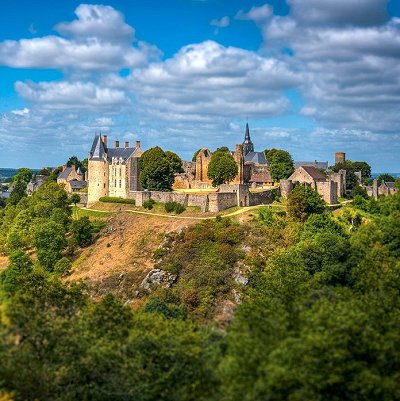
Like us on Facebook
PLACE NAMES


 
|
|
Sainte-Suzanne
|
 |
|
Sainte-Suzanne is a former commune in the Mayenne department in north-western France.[2] On 1 January 2016, it was merged into the new commune of Sainte-Suzanne-et-Chammes. French composer Jean Déré died in Sainte-Suzanne on 6 December 1970.
The City of Sainte-Suzanne built a medieval triangle on a rocky outcrop overlooking the 70 m during the Erve (tributary of the Sarthe), bordering the Forest of Charnie. Its known history dates back to the unsuccessful siege of William the Conqueror in 1083 to 1086 (Camp of the English and dungeon can be visited), but there is also the Dolmen of Erves (oldest monument in the Mayenne) and remains from the Celts ("wall vitrified ").
Nicknamed "The Pearl of Maine", Sainte-Suzanne is the only town in France to be classified at once among the most beautiful villages in France since 2010.
Sight include:
- The Erves dolmen, which is the oldest monument in Mayenne (3500 BC).
- The fortifications of the city, part of which, which rests on a base of vitrified stones, would be of Celtic origin.
- An old paved road (perhaps Gallo-Roman), at the foot of Tertre Ganne, leading to the old ford of Pont-NeufNote 9.
- The city of Sainte-Suzanne
- The keep, barlong, is the oldest monument in the city (first half of the 11th century).
- The Beugy camp or English camp dating from the 11th century was the camp of the troops of William the Conqueror during the siege of the city (1083-1086) against Hubert II de Beaumont.
- The fortress and the medieval city are made up of ramparts from the 12th and 15th centuries, a Guichet gate (or Porte-du-Pont), an iron gate, a Watchtower, a Porte- walled, a South tower, an orientation tower and a North tower. The entrance to the castle is defended by two towers: the 13th century flour tower, and the powder tower, partially destroyed during the wars of religion). The old drawbridge was present at the main entrance of the castle before 1772. The round towers, medieval, and square towers, are adapted to firearms, and date from the end of the 16th centuryNote 10.
- The former status of royal city of Sainte-Suzanne is still noticeable today by the presence of buildings of character in the inner part of the city (former residence of the King's Prosecutors at the beginning of the 16th century, salt loft in the 18th century, former carterie (factory of playing cards), former auditorium of Justice (18th century facade), two mansions and many old houses from the 15th century to the 19th century).
- The house is a 17th century castle, a historical monument. It was built between 1608 and 1610-1613 by Guillaume Fouquet de la Varenne. It is now the property of the General Council of Mayenne. The castle has mullioned windows, pediments, a superposition of orders (Doric below, Ionic on the first floor, Corinthian above); its style announces classicism: sobriety of the decoration, attenuated by a perron in loggia leading to the interior staircase. The castle contains a former bakery and a former stable, which later became a sheepfold.
- The town hall of Sainte-Suzanne (1884), is built where the old halls stood (mentioned in 1528), the location of which is materialized on the ground in Place Hubert II. Just as the roofs of the halls housed the audience of justice, the first floor of the town hall housed the justice of the peace and the court room. Elements of the framework of the halls were reused to build that of the current town hall. The bell that surmounts the roof bears the inscription: "The ear is attentive / To my clear and clear voice / In spite of the bumblebees / Who call me bell".
- The site of Tertre Ganne (access by CD 9, Torcé-Viviers-en-Charnie road), offers traces of old entrenchments (15th century headquarters) and a panoramic view of the city and the castle.
- Many old mills on the Erve: wheat, fuller, paper, tan. Faubourg de la Rivière.
- The postern promenade offers a view over the Coëvrons, the Erve valley, the Charnie forest and, towards Chammes, the plain of Anjou.
- The church of Chammes was not included in the act of restoration of the abbey of Évron, but Hildebert mentions it with its name in the confirmation of the possessions of the abbey in 1125.
Historic events include:
- "The English army" paid by the French Protestants was in Chammes on May 15, 1593.
- Epidemics in 1784-1786. Storms on November 12 and 19, 1810, which damaged the presbytery, located on the banks of the Erve, in "good condition" in 1802 (according to Pierre-François Davelu).
- The seigniory of Chammes was vassal of Sainte-Suzanne. After having belonged to the Feschals (René de Feschal, 15th century; the lady of Poligné, 1469), it passed to the lords of La Chapelle-Rainsouin. In 1562, Nicolas de Champagne engaged him with the so-called seigneury of Vaiges, the smallholdings of l'Hommois, Bonnefontaine, la Messuardière, to sir Olivier Ferré and to Julienne, his wife, lord and lady of La Motte. René Labitte, ordinary judge in the Duchy of Mayenne, had it from Renée Ferré, his wife. It may have passed by acquisition, no doubt, to the Le Doux, lords of Panneterie, and remained with them until the Revolution. They even often left their surname to take that of Chammes: Louise-Françoise-Gabrielle Le Doux de Chammes, lady of Ruigné (Sainte-Colombe), was represented at the assembly of the nobility of Anjou in 1789.
- Chammes constituted a center of resistance to revolutionary ideas through a demonstration of the peasants against the district, from April 2, 1792. The inhabitants had appointed mayor, on November 20, 1791, Jean-Baptiste Cœur, known for his attachment to religion and to the royalty.
 Feel free to Email me any additions or corrections Feel free to Email me any additions or corrections
LINKS AVAILABLE TO YOUR SITE
| | |





